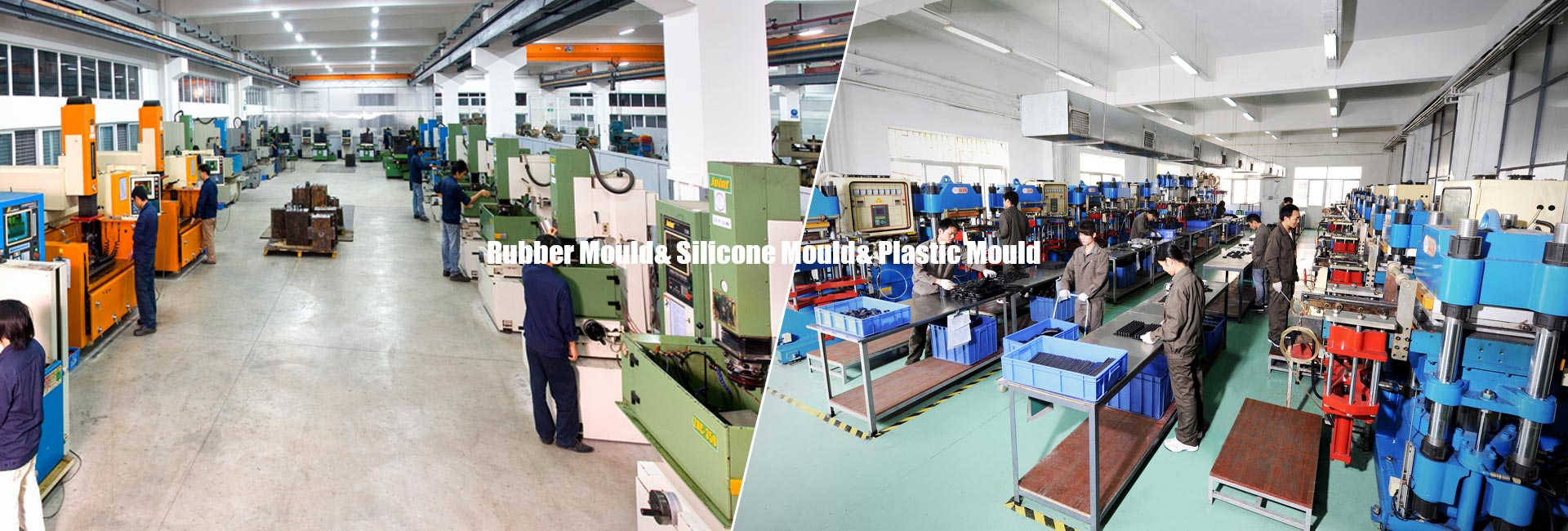Silicone rubber product production process

Silicone rubber products have a complete set of complete production processes from product design, research and development, to mold development, raw material processing, production process and quality inspection.
What is a sample mold?
All silicone products must be made into a silicone mold before production, and new products can be developed through the mold. Now let's introduce our molds.
The sample mold is also called the hand mold. When the customer confirms that we are working with us to ask us to make samples, we first need to provide samples, 2D drawings or 3D drawings. If the customer provides a sample, we will get a 3D map based on the sample. If the customer provides a 3D map, it is more convenient, and our model room master will program the mold according to the 3D map provided by the customer. Usually, the sample is first opened for the customer to confirm, and when the customer confirms that there is no problem, the large mold is opened for mass production.
The sample set of the mobile phone case generally opens from 1 to 2 points. When the sample is much more, our sample mold will also open 4 holes. The sample mold acts as a confirmation initial, which turns the image into a physical object. Because the silicone is flexible, the actual product produced does not necessarily match the drawing. At this time, we only have to open a sample mold and take the sample out for the customer to confirm. If there is a problem with the sample mold, it is relatively simple to modify the mold at this time, the modification time is short, and the efficiency is high. Every time the mold is opened, the mold must be confirmed by proofing, that is, the mold is confirmed. When the product was developed to meet the requirements of the guests, the mold was confirmed.
Sample mold raw material
The sample molds are generally selected from steel materials. The size of the template is determined by the size of the product. A template with a length * width * height of 300 mm * 300 mm * 30 mm is usually used.
Sample mold making time
The length of time the sample mold is produced is determined by the structural complexity of the product. Usually simpler products generally take about 2-3 days from programming to processing; the complexity is about 5-7 days. The more complex the product structure, the longer the mold opening time.
The benefits of opening a sample mold
First, the number of holes in the sample mold is small, the use of the template is small, and the processing time is short, so that the cost is relatively small and the efficiency is high. Secondly, opening the sample mold can bring other benefits. For example, even if the product structure is not confirmed for the first time, it is convenient to modify the mold. After the modification, the proof can be confirmed immediately, which shortens the time. Third, because of the low cost, opening the sample mold first can reduce the risk. If the mold is directly opened, the sample cannot be confirmed for the first time. When the product is produced with the modified mold, there will be many quality problems. In this case, the mold will only be repaired more and more badly. . Therefore, opening a sample mold can achieve the purpose of confirming the product first, and confirm that there is no problem, and open the large mold at one time, so that the products produced have few quality problems.
Important steps before mold making - mold selection

When making molds for silicone products, the first consideration is the choice of mold materials. The selection of the mold is determined according to the quality, quantity, structure, etc. of the product. Mold selection is a very important part of the entire mold making process. The selection of the mold needs to meet three requirements: First, the mold meets the work requirements of wear resistance, toughness, etc. Secondly, the mold meets the process requirements; again, the mold should meet the economic applicability requirements.
(1) The mold meets the working conditions
1. Abrasion resistance When the blank is plastically deformed in the cavity of the mold, it flows and slides along the surface of the cavity, causing severe friction between the surface of the cavity and the blank, which easily causes the mold to fail due to wear. Therefore, the wear resistance of the material is one of the most basic and important properties of the mold. Hardness is a major factor affecting wear resistance. In general, the higher the hardness of the mold part, the smaller the wear amount, and the better the wear resistance. In addition, the wear resistance is also related to the type, quantity, shape, size and distribution of carbides in the material.
2, toughness The working conditions of the mold are mostly very bad, and some often bear a large impact load, resulting in brittle fracture. In order to prevent the mold parts from suddenly breaking during work, the mold must have high strength and toughness. The toughness of the mold depends mainly on the carbon content, grain size and microstructure of the material.
3, fatigue fracture performance During the working process of the mold, under the long-term effect of cyclic stress, it often leads to fatigue fracture. The form has small energy multiple impact fatigue fracture, tensile fatigue fracture contact fatigue fracture and bending fatigue fracture. The fatigue fracture properties of the mold depend mainly on its strength, toughness, hardness, and the amount of inclusions in the material.
4, high temperature performance When the working temperature of the mold is high, the hardness and strength will be reduced, resulting in early wear or plastic deformation of the mold and failure. Therefore, the mold material should have high anti-tempering stability to ensure that the mold has high hardness and strength at the working temperature.
5. Resistance to cold and heat fatigue Some molds are in a state of repeated heating and cooling during the working process, causing the surface of the cavity to be subjected to tensile and pressure-induced stresses, causing surface cracking and spalling, increasing friction and impeding plastic deformation. Reduced dimensional accuracy, resulting in mold failure. Hot and cold fatigue is one of the main forms of hot work die failure, and it should have high resistance to cold and heat fatigue.
6. Corrosion resistance Some molds such as plastic molds work, because of the presence of chlorine, fluorine and other elements in the plastic, after the heat, the HCI, HF and other strong aggressive gases are analyzed, which erodes the surface of the mold cavity and increases its surface roughness. Increase wear and tear.
(2) The mold meets the process performance requirements
Mold manufacturing generally involves several processes such as forging, cutting, and heat treatment. In order to ensure the quality of the mold and reduce the production cost, the material should have good forgeability, machinability, hardenability, hardenability and grindability; it should also have small oxidation, decarburization sensitivity and quenching. Deformation cracking tendency.
1. Forgeability It has low hot forging deformation resistance, good plasticity, wide forging temperature range, low tendency for forging cracking and precipitation of reticulated carbide.
2. Processability The spheroidizing annealing temperature range is wide, the annealing hardness is low, the fluctuation range is small, and the spheroidization rate is high.
3. Machinability The cutting amount is large, the tool loss is low, and the surface roughness of the processing is low.
4, oxidation, decarburization sensitivity High temperature heating anti-oxidation energy is good, decarburization speed is slow, not sensitive to the heating medium, the tendency to produce pitting is small.
5. Hardenability After quenching, it has a uniform and high surface hardness.
6. Hardenability After quenching, a deep hardened layer can be obtained, which can be hardened by using a moderate quenching medium.
7. Quenching deformation cracking tendency The conventional quenching volume change is small, the shape is warped, the distortion is slight, and the abnormal deformation tendency is low. Conventional quenching cracking has low sensitivity and is not sensitive to quenching temperature and workpiece shape.
8. Grindability The relative loss of the grinding wheel is small, and the maximum amount of grinding without grinding is large. It is not sensitive to the quality of the grinding wheel and the cooling conditions, and it is not easy to cause abrasion and grinding cracks.
(3) The mold meets the economic requirements
When selecting a mold, the principle of economy must be considered to reduce the manufacturing cost as much as possible. Therefore, under the premise of satisfying the performance of use, firstly, the price is lower, carbon steel can be used without alloy steel, and domestic materials can be used without imported materials. In addition, the production and supply of the market should also be considered when selecting materials. The selected steel grades should be as small and concentrated as possible, and easy to purchase.
Type of silicone rubber molding
Molded silicone
The molded silicone product is usually formed by applying a pressure through a vulcanizing machine through a high-temperature mold after placing a solid silicone raw material to which a vulcanizing agent is added, and the high-temperature sulfur is solidified. The hardness of the molded silica gel is usually from 30 ° C to 70 ° C. The raw material is matched with the color paste according to the Pantone color card number. The shape of the mold determines the shape of the molded silicone product. The molded silicone product is the most widely used in the silicone industry. Mainly used for only silicone industrial accessories, buttons, silicone gifts, silicone bracelets, silicone watches, key bags, mobile phone sets, silicone kitchen utensils, silicone pads, ice trays, cake molds, etc.
Extrusion silicone
The extruded silicone product is usually formed by extruding a silica gel by an extrusion machine. Generally, the shape of the extruded silicone is long, and the tubular shape can be cut at will, but the shape of the extruded silicone has limitations and is widely used in food machinery.
Liquid silicone
The liquid silicone product is injection molded by silicone injection molding. The product is soft and has a hardness of 10 ° C to 40 ° C. Due to its soft characteristics, it is widely used in simulating human organs.
Silicone Molding
Similar to injection molding, silicone molding is the process of injecting and curing liquid silicone rubber inside a mold. The nature of the material means that varying durometers are available, and parts are especially well-suited to sterilization. For this reason, silicone molding is often the choice for medical-grade, food-grade and other specialty custom plastic molding projects.
Our main products include wristbands, MP3/4/5 covers, silicone nipples, insulators, and rubber sundries, PVC sundries. All our products have good quality, nice shape, extractive packing and reasonable price.

